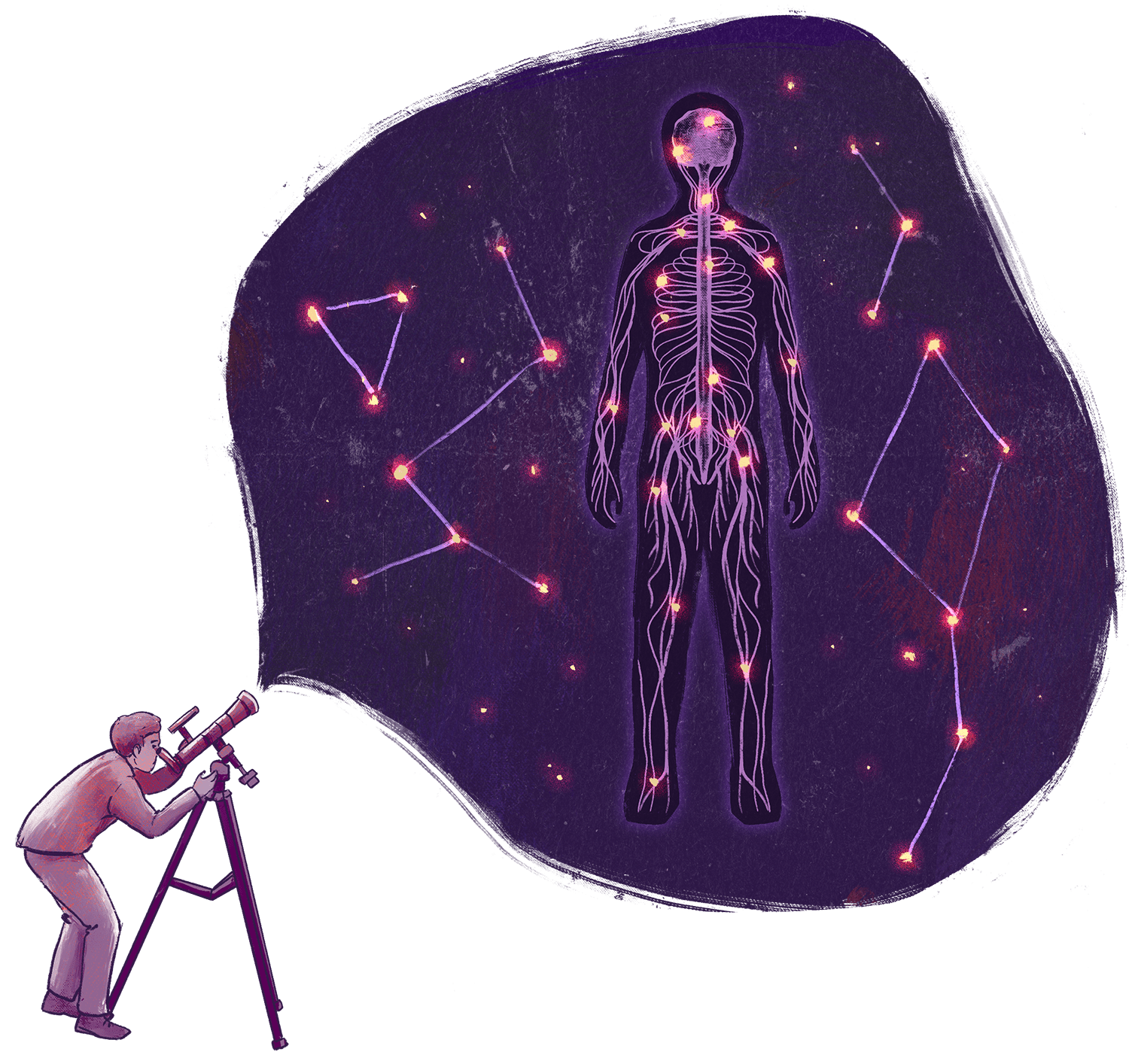Getting acquainted with your nervous system
IN PARTNERSHIP WITH UNLIKELY COLLABORATORSIllustrations and animation by Olga Kurkina
by Sonia Chien
In our day-to-day lives, there are plenty of familiar reasons why we might feel stressed or stretched thin — work pressure, a long to-do list, personal challenges, and more. But there’s a deeper, often overlooked element that could be blocking our ability to take potential stressors in stride: our autonomic nervous system (ANS), and the way we perceive and regulate it.
What’s more, these deeply embedded perceptions can shape how we respond to external events — in subtle and powerful ways. If we can consciously shift our perception of these physiological signals, we can tap into a better balance between stress and calm. It is actually possible to rewire how we perceive and react to stressors over time. With intentional practice, we can shift our internal perceptions, helping our nervous system to better regulate and our body to respond with more resilience.
Through most of my twenties, I felt perpetually rushed, as though there was never enough time in the day. Whether I was running late for an appointment or simply sitting at my desk, I often had the nagging feeling of being behind. My heart would race, and I’d catch myself unknowingly holding my breath. I knew that there had to be an easier way to live, but I didn’t know where to start.
If this experience sounds familiar, you could be caught in an ongoing fight-or-flight response. “For many of us living in hustle culture and in a society that measures our worth in terms of productivity, this is a common pattern, and not a healthy one,” says Dr. Alice Kerby, creator of the Kerby Method, a physical therapy methodology which integrates passion for movement and nervous system regulation practices. “Having a nervous system that is well-regulated is hugely important for mental and physical health and overall well-being.”
For me, real change began when I started exploring the role of the nervous system in my own well-being and learning regulation practices. I began to understand that this seemingly constant state of stress wasn’t just an emotional or mental experience — it was something deeply physical, triggered by how my body was perceiving the world around me. I was essentially stuck in a cycle where my perception of my environment, and my body’s reaction to it, were unregulated.
The first step toward healing, for me, was understanding what the nervous system actually does.
What is the autonomic nervous system?
Olga Kurkina
The autonomic nervous system (ANS) is a vast, interconnected web of nerves in the body which regulates many automatic functions such as breathing, heartbeat, digestion, and body temperature. It’s essentially the body’s way of processing and responding to both internal and external stimuli without needing conscious thought.
“The autonomic nervous system is connected to all our major organ systems and is constantly inputting information into our system below the level of conscious awareness,” explains Dr. Kerby. “So the ANS is a major player in how we process information externally and internally.”
It is comprised of three distinct parts: the parasympathetic system, the sympathetic nervous system, and the enteric system.
The sympathetic system (SNS), most famously known as the executor of the “fight or flight” response, starts in the brain stem and connects to the rest of the body via extended nerve fibers. It is responsible for our body’s response in times of stress.
“[Fight-or-flight] is an evolutionary adaptation to help us either get ready to attack or run away,” says Dr. Mark Williams, Professor of Cognitive Neuroscience and author of The Connected Species. “One major issue with our current lifestyle is that people are often in a stressed state. This sets off this response when it’s not actually helpful.”
The parasympathetic system (PSNS), or “rest and digest” system, also originates from the brain stem and connects to other regions of the body. It is responsible for activities which signal the body to slow down in order to conserve energy and/or recover, such as decreasing heart rate after a stressful encounter or post-exercise.
The enteric system (ENS), or “gut brain,” is a system of nerves that lines the gastrointestinal tract. In addition to maintaining digestion, the ENS has also been shown to be in strong communication with our brain and is closely linked with mood, earning it the term “Brain-Gut Connection.”
“If we’re constantly stressed over one thing or another, and our stomach is clenched and tight, the sensory neurons in our [ENS] send signals to the brain telling us we aren't ok,” says Dr. Kerby.
Why do we have an autonomic nervous system?
The ANS evolved to prevent us from becoming overwhelmed. “Think about how difficult it would be if we were not only aware of everything we can see, hear, touch, and smell, but also our heart rate, breathing, digestive system, veins, and so on,” describes Dr. Williams.
In their roles as our respective “stress” and “relax” signals, the SNS and PSNS create a Yin and Yang effect within the body. Ideally, these systems should be in balance. If they are not, however, our Window of Tolerance, or zone of effective functioning, can shrink.
When our sympathetic system is overstimulated — say, by chronic stress or unresolved trauma — we enter a “fight or flight” mode that’s more difficult to escape. This leaves the body in a state of hypervigilance, where even seemingly small, benign stimuli can trigger big feelings of anxiety or discomfort.
What can we do to regulate our nervous system?
Olga Kurkina
The exciting part is that the ANS is not fixed — our perception of stress can shift. When we’re stuck in an unregulated stress response, our outlook is often dominated by feelings of overwhelm and anxiety. But through targeted practices like nervous system regulation, we can create space for a calmer, more grounded perspective.
The key is consciously training ourselves to notice and regulate the signals our nervous system is sending, in real-time.
When I began seeing a somatic-oriented therapist — a practitioner whose approach allows for expanded awareness of the body — I started learning practical ways of regulating myself. These included techniques as simple as closing my eyes and visualizing a calm place, or picking a color and noticing objects of that color while walking.
I also learned how to exercise the vagus nerve, which plays an important role in the parasympathetic nervous system. The vagus nerve acts as an information delivery system to the brain, managing involuntary functions such as breathing, digestion and heart rate. Stimulation of the vagus nerve has proven mood-enhancing effects.
Shifting my perception of my body’s responses to stress allows me to find a sense of peace – even in challenging situations, even when I have to manually override my body’s initial response.
To help begin this shift from fight-or-flight to a more balanced existence, Dr. Kerby recommends slowing down our lives as much as possible, both when it comes to “free/unscheduled time, and in a moment-to-moment sense.”
Both Dr. Kerby and Dr. Williams recommend cultivating sensation awareness in our daily lives, including bringing attention to our breath, emotions, and body temperature. If we can interrupt automatic stress responses, we can begin to recalibrate the nervous system. (Dr. Kerby’s free online course for nervous system regulation is here.)
Other practices, such as yoga nidra – a form of guided, rest-oriented meditation that brings attention to the body – and somatic therapy – an approach which allows for expanding awareness of the body – could be helpful.
While it’s still a work in progress, learning about the nervous system has gradually brought more balance to my daily life. Allowing myself to slow down has turned out to be one of the most important parts, because racing thoughts don’t run forward, they run in a circle. Reminding myself of that, as well as paying attention to my body’s physical cues, has made moving towards the goals I set for myself a whole lot easier.
My body communicates with me, and I am learning to listen.
Sonia Chien is a freelance writer and aspiring fiction author. She studied politics in her hometown of Boston, MA, before receiving her MA in Journalism in Berlin, Germany, where she currently lives. Sonia enjoys exploring new genres and debating hot takes.
Olga Kurkina is a medical and editorial illustrator specializing in transforming complex concepts into visually appealing images for publications and animation. She currently lives and works in Poland.



